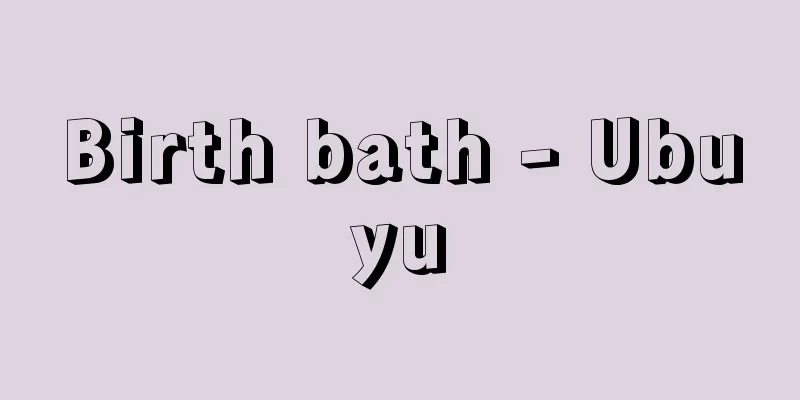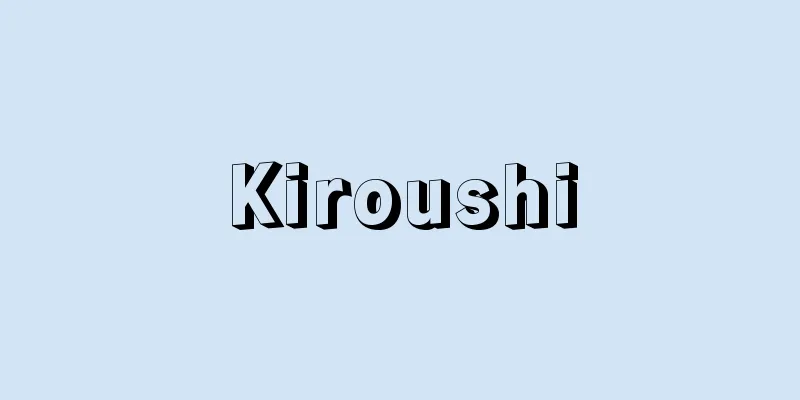Birth bath - Ubuyu

|
This is the bath water given to newborn babies. Vernix caseosa adheres to the skin of a fetus while in the amniotic fluid of the mother's womb, and blood and other substances adhere to the skin during the birth process. This bath is used to wash these away. Usually, a bathtub for newborns is used, but a clean basin can also be used. The standard temperature of the bath is about 38°C in summer and 40°C in winter, and it is common to wash the baby quickly to reduce the burden on the newborn. [Hoashi Eiichi] FolkloreThe bath that the midwife bathes the baby in immediately after birth is usually called the birth bath, but in some regions the bath on the third day is called yuzome or ubuyu. Even in the birth customs of noble people, the third day bath is important and is accompanied by various ceremonies, so it is clear that the bath at this time has a large ceremonial aspect. Among ordinary people, in many places, it is customary for the baby to be wrapped in cloth when it is born, and only after the third day bath is it dressed in a kimono with sleeves called ubugi or tetoshi. In Sado, Niigata Prefecture, the kimono worn on the third day is called ninjugimon (people's kimono). In this region, ninju means a member of the community, that is, a kimono worn when joining the human community. There are many customs regarding the birth bath itself, but care should also be taken when disposing of the bath, such as disposing of it in a shady place, under the floor of the birthing room, or by considering the direction. There is also a superstition that if the bath is disposed of in the wrong place, the baby will cry at night. [Hisako Maruyama] [Reference] |Source: Shogakukan Encyclopedia Nipponica About Encyclopedia Nipponica Information | Legend |
|
生まれたての新生児につかわせる湯をいう。胎児には母胎の羊水内で皮膚に胎脂が付着しており、また出産の過程で血液などが付着する。これらを洗い落とす目的で用いる。通常は新生児用の浴槽を使うが、清潔なたらいなどを使用してもよい。湯の温度は夏季で38℃、冬季で40℃ぐらいが基準とされており、新生児への負担を軽減するため、手早く済ませるのが一般的である。 [帆足英一] 民俗出産直後に、産婆によって沐浴させる湯を普通には産湯とよんでいるが、地方によっては3日目の湯浴みせをユゾメとかウブユなどとよぶ所がある。高貴の人々の誕生習俗でも、3日目の沐浴を重視してさまざまな儀式を伴うので、このときの沐浴は儀礼的な面が大きいことがわかる。一般常民の間で、多くの土地に伝承されていることは、子供が生まれると普通は布裂(ぬのきれ)に包んでおいて、3日目の湯浴みせのあと初めてウブギとかテトオシとよぶ、袖(そで)のついた着物を着せる習わしのあった所が多い。新潟県の佐渡ではこの3日目に着せる着物を、ニンジュギモン(人衆着物)という。ニンジュとは、この地方で仲間ということ、すなわち人間の仲間入りして着る着物という意味である。産湯そのものにもしきたりが多いが、捨てる場所にも心を使って、日の当たらない所、産室の床下、方角をみて捨てるなどということがある。もしこの場所が悪いと子供が夜泣きをするという俗信もある。 [丸山久子] [参照項目] |出典 小学館 日本大百科全書(ニッポニカ)日本大百科全書(ニッポニカ)について 情報 | 凡例 |
<<: Yuwen Kai (English spelling)
>>: Ubuyama [village] - Ubuyama
Recommend
Theft - Setto Uzai
It is a type of property crime, and is punishable...
Schwabe - Heinrich Samuel Schwabe
German amateur astronomer. Born into a family of ...
Dai Viet (English spelling)
The name of the country of Vietnam used from 1054 ...
Euphorbia pseudochamaesyce (English spelling)
… [Morita Tatsuyoshi]. … *Some of the terminology...
Iwamuro Flora
...The composition of the Kuruma flora is quite d...
Italy - Let's go
…Many scientific expeditions were conducted durin...
Gulf of Tonkin
A branch of the South China Sea bounded by the no...
Vagus nerve
It is the 10th cranial nerve in vertebrates, and ...
Iwakunisho - Iwakunisho
… [Hajime Miura] [Iwakuni Castle Town] Ishikuni S...
Administrative legislation - Gyosei Rippo
The executive branch makes general and abstract pr...
Exuviaella marina (English spelling)
… Ceratium hirundinella grows in large numbers in...
Akahara (fish) - Akahara
…It has many local names such as Akauo (Nagano Pr...
three-day event
...There are also other special events such as ju...
Shuzenji [town] - Shuzenji
An old town in the northern part of the Izu Penins...
Horseback shooting - Kisha
It is an archery technique in which a horse is mo...







![Kurodasho [town] - Kurodasho](/upload/images/67cb7379285ba.webp)

